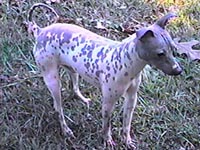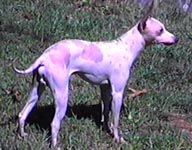 |
 |
 |
 |
GENERAL APPEARANCE: The dog's body is neat and trim, resembling a small deer. The dog's carriage and confident manner should give the appearance of vigor and self-importance. A small lively active and alert companion dog, not a heavy muscled working dog.
HEIGHT: From withers to ground the measurement should be 12 1/2 to 18 inches.
WEIGHT: Weight in proportion to height should be 11 to 17 pounds.
HEAD: Slightly rounded with medium long muzzle and medium stop. Muzzle is thinner and tapers to the nose. Stop is approximately one half the length from the tip of the nose to the occiput.
EARS: Moderate in size. Naturally erect, tipped or button.
TEETH: Full dentition with
level or scissors bite. Slightly over or under will be permissible
at this time due to the small gene pool. *Once the gene pool is sufficiently
increased the slightly over or under bites will not be allowed. Missing
teeth a fault.
.
EYES: Round with an alert
expression. Eyes may be any color.
NOSE: Self-colored
NECK: Medium length with a graceful arch.
BODY: A moderately muscled body which is slightly longer than the height. Rump curves slightly to the tail set. Long straight forelegs with toes turning neither in or out and moderately angulated hindlegs with hocks neither turning in or out.
TAIL: Moderately long and carried up or back.
FEET: Compact and oval with medium length nails. Splayed feet a fault. Dewclaws may be left or removed
SKIN: Warm to the touch,
soft and smooth. Skin may be covered with a very very fine, almost
undetectable layer of minute hair. This does not resemble normal hair and
normal hair on any part of the body other than whiskers or eyebrows is
considered a disqualification. Puppies are born with hair and will begin
losing the hair in a week,
starting at the nose and receding in a
band toward the back until they are hairless at 6-8 weeks. When hot
or scared they will break into a sweat. This is not to be faulted.
COLOR: Dogs may be of any color. Parti-colored dogs with general color of pink and freckles or with spots of contrasting colors will darken with exposure to the sun and the freckles will enlarge and even join as the dog ages. The black and tan colored dog will remain the same.
GAIT: Graceful and kind of cocky
DISQUALIFICATIONS: Severe under or overshot bite, normal hair on any part of the body other than whiskers or eyebrows, hanging or hound dog ears, viciousness or extreme shyness, monorchid or cryptorchid, docked or short tails, dogs oversized by more than one inch or one pound.
Rule One: You may only breed an approved registered AHT to an approved registered Rat Terrier. No other breed of dog will be allowed by NAHTA ...no exceptions. The Rat Terriers should have long or docked tails, not natural bob tails. It is also preferred the Rat Terrier be the longer legged type to stay within the style of the American Hairless Terrier. The best dogs of this breeding will be used in the next breeding. All dogs not used in a subsequent breeding will be spayed/neutered. A copy of the spay/neuter certificate will be forwarded to the club as verification of this action being taken and then the dogs will be placed in pet homes. All pups from this breeding will be coated and will be registered as an American Hairless Terrier/Rat Terrier Cross.
Rule Two: The dogs (hybrids) from the first out-cross are now bred to an approved registered AHT. Neither of the dogs should be closely related to each other (sire, dam, or half-sibling). Any coated dogs not to be used in a future breeding will be spayed/neutered. A copy of the spay/neuter certificate will be forwarded to the club as verification of this action being taken and then the dogs will be placed in pet homes. Any hairless should be held till evaluated and if not of breeding quality, spayed/neutered and placed as a pet. This out-cross of hybrid to hairless should produce hairless and coated pups. The coated pups will again be registered as "crosses" and the hairless registered as American Hairless Terriers.
Rule Three: The best dogs (hybrids or hairless) from the second out-cross are again bred to an approved registered AHT. Breeding hybrid to hairless will produce a mixed litter of coated and hairless. Breeding hairless to hairless will always produce totally hairless litters.
Authorization: Each dog used in the out-cross program must be authorized first by an assigned NAHTArepresentative. The representative will need to see the dog(s) in person or by good videotape which shows movement, color and markings, size, and temperament. The representative must also see a copy of the dog's registration and a three-generation pedigree. Once accepted by the representative, the dog must be checked by a veterinarian for serious faults, (i.e. the NAHTA Breed Standard), be checked for a proper bite, its temperament, and for luxating patella's. A DNA sample must also be done on any dogs to be bred. The veterinarian will fill out the form provided and if the dog(s) pass inspection, they will be allowed into the NAHTA Out-cross Program. All resulting offspring to be used in the out-cross program must also have authorization and pass the same veterinarian inspection. All not used or that do not pass must be spayed/neutered and placed as pets.
Registration: All dogs to be used in the NAHTA Out-cross Program whether they be Rat Terriers, Crosses, or American Hairless Terriers, must be registered. All the coated offspring from the first and second out-cross will be registered as American Hairless Terrier /Rat Terrier "Cross". Hairless dogs from the second and third out-cross will be registered as American Hairless Terriers. The registry has also made it possible for us to have "Certified Toy", "Sire and Dam Certified Toy", "OFA Certified Patella Clear", and "DNA Profiled" imprinted on our dog's Registration Certificates. This will definitely help breeders select the proper dog for their out-crossing needs.
Out-crossing is a serious endeavor.
Please read the rules carefully before making a decision to venture into
this. Talk with other breeders and talk with Mr. Scott beforehand. The
future of the American Hairless Terrier relies heavily on what we as breeders
do for them today.
.PREVIOUS
PAGE
| Back to Index NRTA |